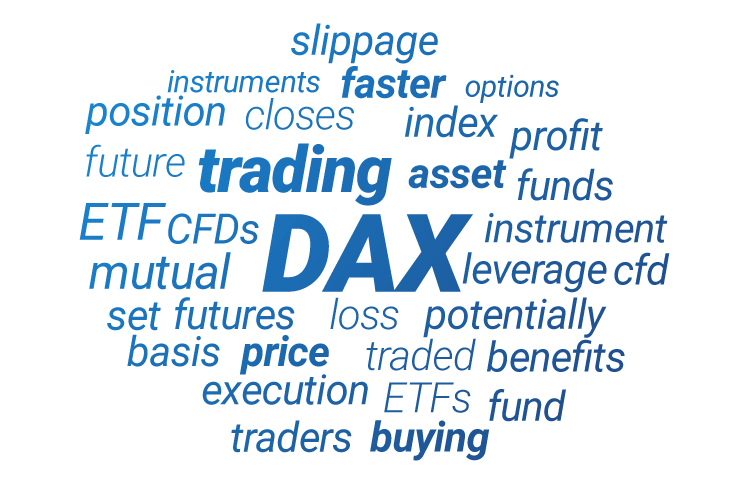How to Trade the DAX?
The DAX index is made up of the 40 largest German corporations when weighted by market cap and liquidity. The DAX index can be traded either indirectly or through the use of stand-in instruments that track its performance.
One way to trade the DAX index would be to trade the stocks of each company that makes up the DAX. However, this can be time-consuming, as all 40 companies would need to be tracked.
Another way to trade the DAX would be to work with a broker who offers mutual funds or ETFs which include DAX stocks in their baskets. These would be mirrored to reproduce the same weighted mix as the DAX.

Trading on the DAX40
Trading CFDs allows traders to speculate on the movement of the DAX without the need to purchase the underlying assets. Instead, traders agree to accept the difference in price between when a position opens and when it closes.
Some of the benefits that trading CFDs can offer include the ability to use leverage, faster settlements, potentially reduced slippage because of faster trade execution, and the lack of commission fees. Another benefit is that CFD traders can potentially profit from the instrument price if the price goes up or down by either going long or going short. However, traders should remember that trading CFDs is risky and can result in the loss of their entire capital.
When using the Plus500 platform, there are two ways to trade on the DAX (Germany 40), futures CFDs and options CFDs.*
Futures CFDs - Futures trading involves opening buy or sell positions on an instrument and then taking a profit or loss on the difference in the instrument’s price from the beginning to the end of the transaction. Traders place a Buy (or Long) position if they believe the asset’s price will rise in the future. Traders place a Sell (or Short) position if they believe the asset’s price will drop in the future.
Options CFDs* - When trading options CFDs, traders are speculating on the future price (strike price) of an underlying instrument such as a stock, index or commodity. For more information on options trading, please refer here.
Benefits of Trading Dax CFDs
Leverage
One of the biggest benefits of CFD trading is the use of leverage. With traditional mutual funds and ETFs that are acquired through brokerages, you need to set aside the full value of the instruments you are purchasing at a 1:1 ratio. However, with CFDs, you can put down a fraction of the asset’s value, and still experience any profit or loss as if you had provided the full value. This means that if an asset is traded at a 1:20 leverage, you only need to set aside 5% of the opening price. When the trade closes, the amount that you make or lose will be multiplied by twenty times. Trading with leverage increases a trader’s buying power, which can in turn increase the risk of bigger losses.
Let’s look at an example. If the instrument trades at $2000 at a 1:20 leverage, then you only need to put down $100 to purchase 1 contract of that asset, instead of the full $2000 value of the asset. If the price then went up to $2500, your profit would be $500, on the basis of that $100 margin. Of course, if the asset price went down to $1500, your loss would be $500 on the basis of that same $100 margin.
Rapid executions
Mutual Fund and ETF trading typically have a relatively slow speed of execution, and frequently come with an increased risk of slippage. This makes it harder to determine the actual price at which your positions will open or close.
CFD trades can be opened within seconds, potentially making the effects of slippage much smaller.
*Instruments availability subject to regulation.
